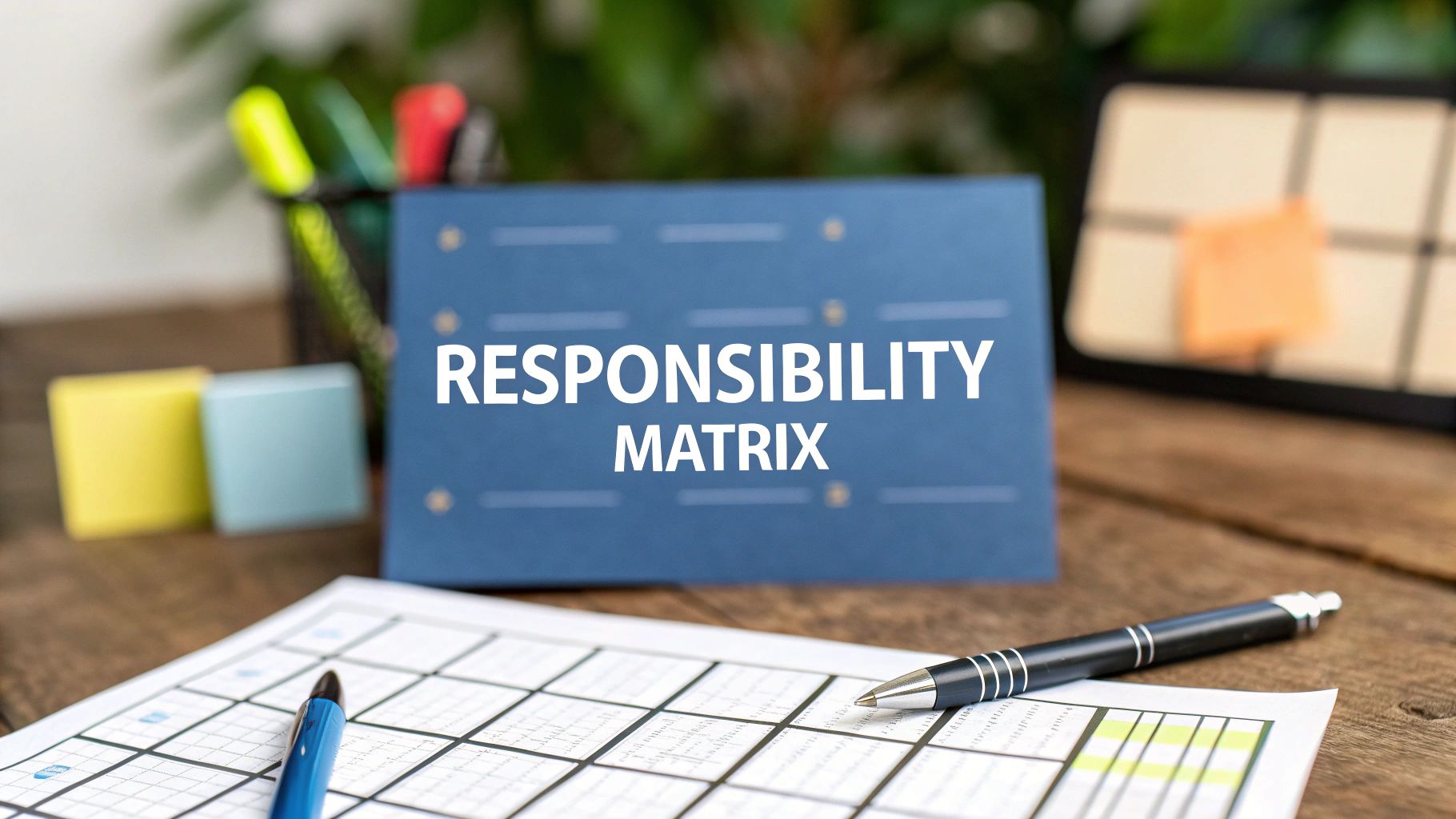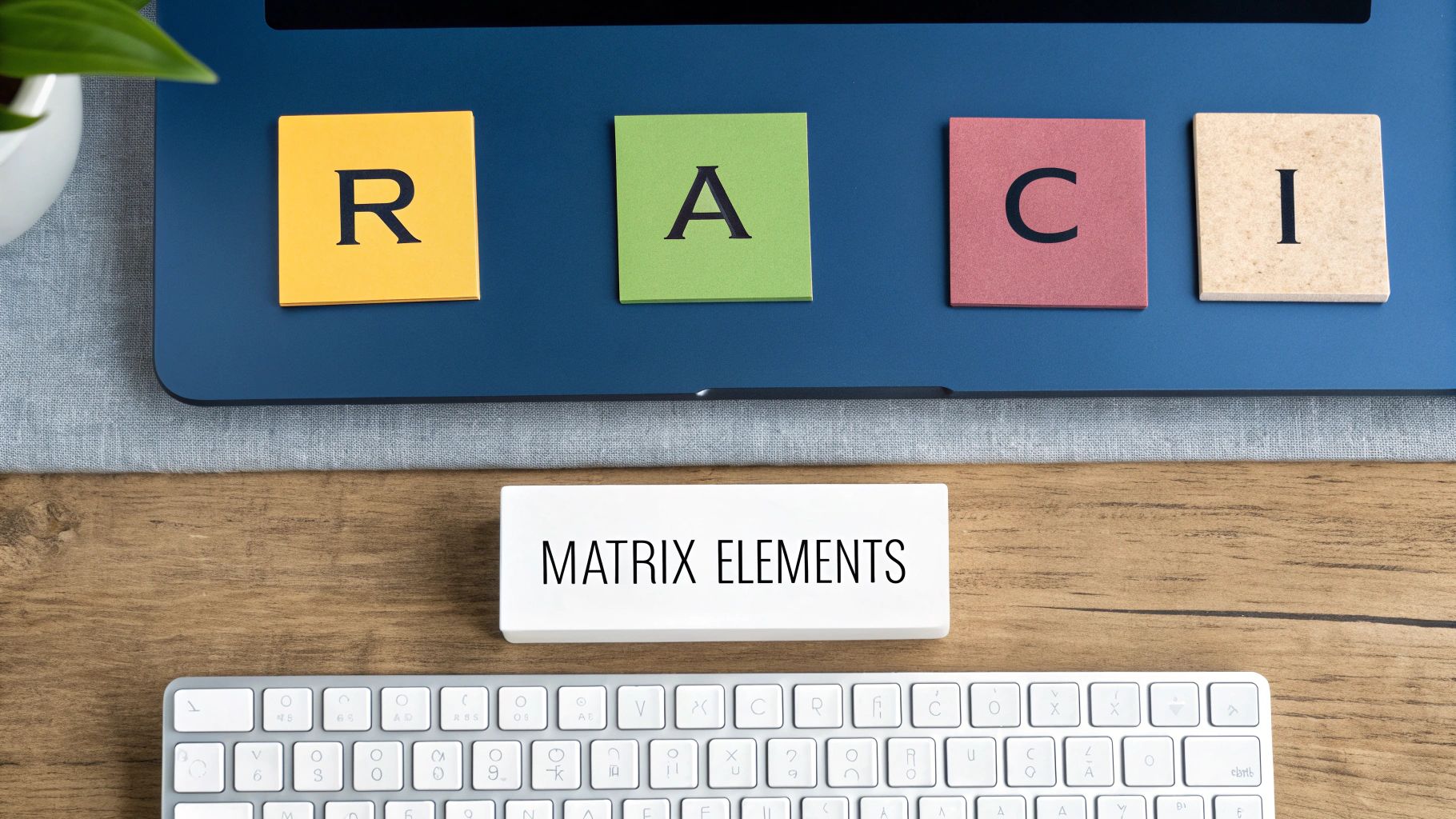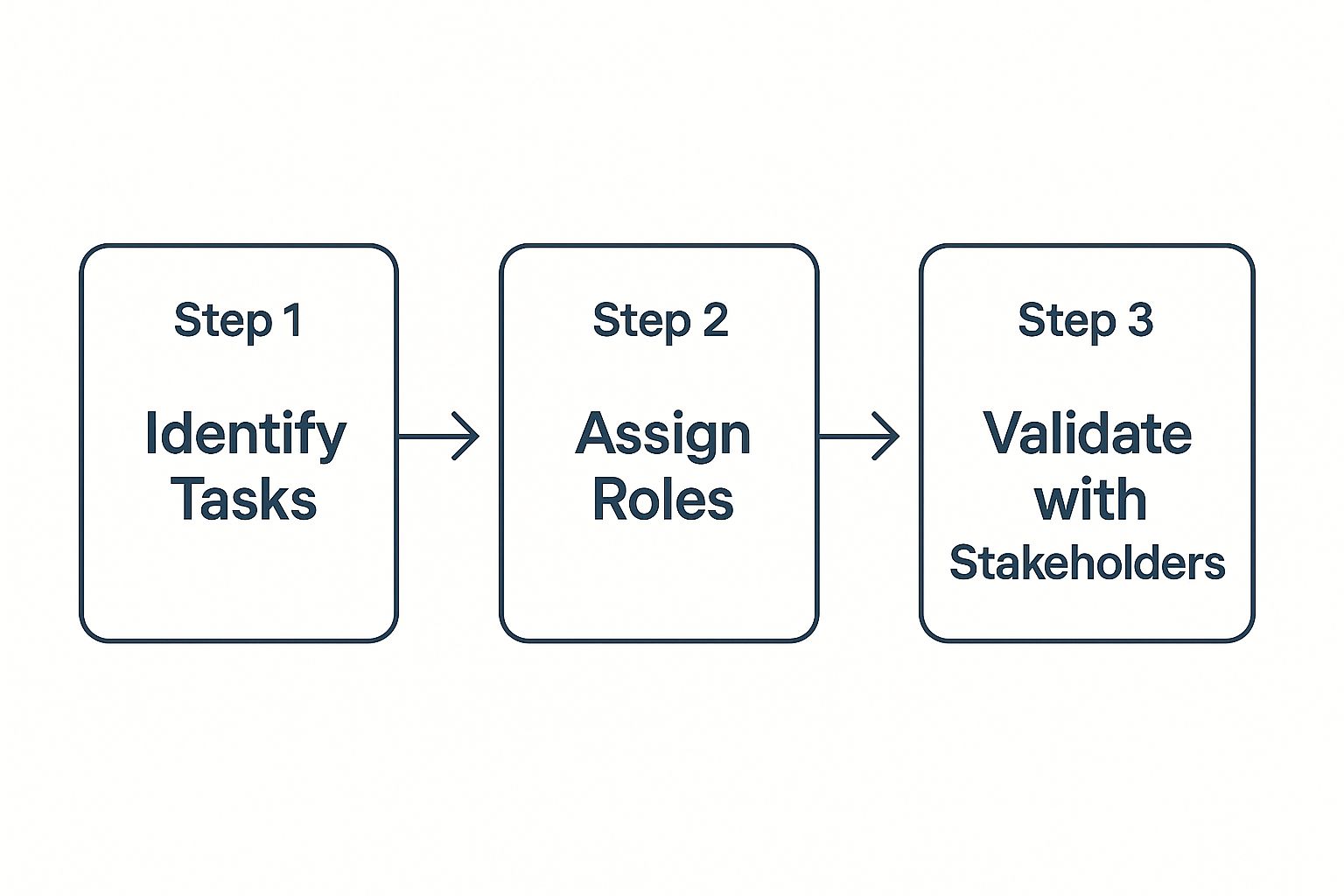
Ever kicked off a project only to hear the dreaded phrase, "I thought you were doing that," a few weeks down the line? It’s a classic sign of role confusion, a problem that can derail even the most well-intentioned teams.
A responsibility assignment matrix is the simple, powerful tool designed to stop that conversation before it ever happens. Think of it as a chart that makes it crystal clear who is doing what, ensuring every single task has an owner. It’s all about defining roles and expectations right from the start to avoid confusion, missed deadlines, and wasted effort.
What Is a Responsibility Assignment Matrix

Imagine a top-tier kitchen during a busy dinner service. The head chef isn't chopping vegetables, and the person washing dishes isn't plating the main course. Everyone has a specific role, and they know exactly how they contribute to the final meal. The result is a smooth, efficient operation.
A project without a clear responsibility assignment matrix (RAM) is the exact opposite—it's kitchen chaos.
A RAM, most famously known as a RACI matrix, is your team’s playbook. It’s a simple grid that maps out every project task against every person involved. At a glance, it answers the most critical questions: Who is actually doing the work? Who has the final say? Who needs to give their input? And who just needs to be kept in the loop?
The Four Key Roles in a RACI Matrix
The RACI framework is the most popular type of RAM for a reason: it’s simple and it works. The acronym stands for four distinct roles that, once assigned, eliminate ambiguity and get everyone on the same page.
Let's break down what each letter in RACI actually means in practice.
| Role | Meaning (Who is this person?) | Action (What do they do?) |
|---|---|---|
| Responsible | The "Doer" | This is the person (or people) physically completing the task. They are the hands on the keyboard. Actionable Step: List the team members who will actively work on the task here. |
| Accountable | The "Owner" | This individual is ultimately answerable for the task's success. There can only be one Accountable person. Actionable Step: Assign the single person who has final sign-off authority. |
| Consulted | The "Expert" | These are the people you go to for input or advice. Think subject matter specialists. Actionable Step: Identify stakeholders whose feedback is required before the work is completed. |
| Informed | The "Stakeholder" | These people are kept up-to-date on progress but aren't actively involved in the task. Actionable Step: List anyone who needs status updates but isn't part of the core delivery team. |
Getting these roles straight is a huge part of defining the scope of a project, as it forces you to think about who is needed for every single deliverable. For a broader look at how RACI fits into the world of project management for agencies, this guide offers some fantastic insights.
A well-crafted RACI chart turns project management from a guessing game into a coordinated, predictable effort. It ensures every team member knows their exact contribution and value.
This isn't just theory; it has a real impact. In the Netherlands, for example, a 2023 survey found that 78% of medium-to-large enterprises use the RACI model in at least 60% of their projects. More importantly, those organisations reported a 35% reduction in role confusion, proving just how effective this simple grid can be for boosting clarity and efficiency. You can see more on how Dutch companies are using these frameworks at this project management resource.
Why a RACI Matrix Is Your Project's Secret Weapon

Defining roles on paper might feel like just another piece of admin, but its impact on a project is enormous. A responsibility assignment matrix is the tool that turns confusing overlaps and vague responsibilities into clear, actionable steps. It cuts through the small misunderstandings that quietly grow into major delays.
When you clearly outline who does what, you remove the friction that slows teams down.
This clarity has a direct impact on decision-making. If there’s a single person marked as ‘Accountable’ for a task, there's no debate about who has the final say. That simple designation breaks up bottlenecks and keeps the project moving, which is a massive advantage when deadlines are tight. A RACI matrix is a true secret weapon because it optimises the organizational structure in project management, giving every task a clear owner.
Boost Efficiency and Eliminate Rework
One of the first things you’ll notice with a good RACI chart is how much duplicated effort disappears. When team members know exactly what falls under their remit, they stop accidentally spending time on work someone else is already handling. This saves time and prevents the costly rework that happens when two people deliver conflicting results for the same task.
The data backs this up. Research on Dutch companies found that projects using the RACI model hit a 92% on-time completion rate. For those without a clear responsibility framework? Just 69%. That same research showed that duplicated work was cut in half, proving a direct link between role clarity and project efficiency.
By assigning clear ownership from the start, a RACI matrix transforms a group of individuals into a coordinated team. It builds a foundation of accountability that empowers people to perform their roles with confidence.
Enhance Team Morale and Communication
Beyond the obvious efficiency gains, a transparent RACI chart has a huge effect on team morale. Uncertainty about roles and responsibilities is stressful, and it often leads to burnout when workloads feel unfairly distributed. A RACI chart tackles this head-on by making everyone’s contributions visible and assignments equitable.
This transparency creates a healthier work environment where everyone understands their value. Here are some actionable benefits for your team:
- Reduced Conflict: When roles are crystal clear, arguments over ownership and responsibilities fade away. Actionable Step: Use the matrix as a reference point during disagreements to quickly resolve who is accountable for a decision.
- Improved Onboarding: New hires can get up to speed in record time because they can see the project structure and exactly where they fit in. Actionable Step: Make the RACI chart part of your standard onboarding package for new team members.
- Better Communication: Knowing who to consult or inform for any given task means the right people are always in the right conversation. Actionable Step: Encourage the team to check the RACI before sending emails or scheduling meetings to ensure the right people are included.
Ultimately, this clarity empowers team members, cuts down on frustration, and helps prevent the burnout that can derail even the best teams. It makes the RACI matrix an indispensable tool for long-term project success.
How to Build Your First Responsibility Assignment Matrix
Jumping in to create your first responsibility assignment matrix can feel a bit daunting, but it’s actually a pretty straightforward process that pays off almost immediately. By mapping out roles and tasks, you’re not just making a chart; you’re building a powerful reference tool that cuts through confusion and keeps everyone on the same page.
Think of it as creating a simple grid that anyone can understand in a single glance. It's all about listing what needs doing, figuring out who's involved, and then methodically giving each person a clear role for every task.
The infographic below breaks this down into a simple, three-stage flow.

As you can see, a solid RAM is built logically. You start by defining the work, then assign ownership, and finally, get everyone to agree on it. Here’s a step-by-step guide to get it done.
Step 1: List All Project Tasks
The bedrock of your matrix is a complete list of every task and deliverable. You want to be thorough here, but don't get lost in the weeds with tiny administrative details. Stick to the significant milestones and the key activities needed to hit them.
A work breakdown structure (WBS) is your best friend for this step. It’s a fantastic way to break a massive project into smaller, more manageable chunks. If you're new to the concept, these work breakdown structure examples for project management are a great starting point. Actionable Step: Open a spreadsheet and list 5-10 major project deliverables in the first column. This will form the Y-axis of your matrix.
Step 2: Identify Team Members and Stakeholders
Next up, list everyone who has a hand in the project. This isn’t just about the core team doing the hands-on work. You also need to include key stakeholders—think department heads, clients, or executive sponsors who need to be kept informed. Actionable Step: In the same spreadsheet, list the names or roles of all involved parties across the top row. This will form the X-axis of your grid.
Step 3: Assign RACI Roles for Each Task
Now it’s time to fill in the grid. This is where the magic happens. Go through each task, look at each person, and assign them one of the RACI codes: R, A, C, or I. This is the most crucial part of the process and requires some careful thought.
A few golden rules to follow:
- One ‘A’ Per Task: Every single task must have exactly one person who is Accountable. This prevents indecision and creates a single, clear owner. No exceptions.
- At Least One ‘R’: Every task needs at least one person who is Responsible for getting the work done. It’s perfectly fine to have several people in this role if it’s a team effort.
- Don't Overload Anyone: Keep an eye on how the roles are distributed. If one person has a long list of 'R's next to their name, they could quickly become a bottleneck or risk burning out.
Actionable Step: Begin filling the cells where the task row and team member column intersect. Start with the 'A's and 'R's first, as these are the most critical roles to define.
Step 4: Review and Get Team Buy-In
Once you have a draft ready, don’t just send it out and call it a day. Share it with the entire team. A RACI matrix is a team tool, not a command from on high. Set up a meeting to walk through the assignments, clear up any fuzzy areas, and tweak it based on everyone’s feedback. Actionable Step: Schedule a 30-minute meeting with the project team. Share your screen, review the matrix row by row, and ask directly: "Does everyone agree with these assignments?"
A responsibility assignment matrix is most effective when it is a living document that the entire team understands and agrees upon. This collaborative review process is essential for securing commitment and ensuring the matrix reflects reality.
This last step is what turns a simple chart into a shared pact. It clarifies who does what, sets expectations, and empowers everyone on the team to do their part with confidence.
Real-World Examples of a RAM in Action

Theory is one thing, but seeing a responsibility assignment matrix solve a real problem is where it all clicks. When you watch this simple grid untangle a messy workflow or clear up a communication bottleneck, you start to see its true value.
Let's walk through three common scenarios to see how a RACI chart brings order to very different kinds of projects. Each example shows how the matrix cuts through the noise and defines ownership where it matters most.
Example 1: Launching a Marketing Campaign
Imagine a team getting a new digital advertising campaign off the ground. You've got a content writer, a designer, a paid ads specialist, and a marketing manager all in the mix. Without clear roles, it’s a recipe for crossed wires. Who gives the final thumbs-up on the ad copy? Does the designer really need to be in every single review meeting?
Here’s how a simple RAM for the task "Finalise Ad Creative" clears things up instantly:
- Responsible (R): Graphic Designer (creates the visual), Content Writer (writes the copy).
- Accountable (A): Marketing Manager (owns the final deliverable and its results).
- Consulted (C): Paid Ads Specialist (gives input on ad specs and platform rules).
- Informed (I): Head of Marketing (just needs to know when the creative goes live).
Actionable Outcome: The Designer and Writer know they must get final approval from the Marketing Manager, who in turn knows to seek input from the Ads Specialist before signing off. The Head of Marketing is saved from unnecessary meetings.
Example 2: A Software Development Sprint
In an agile software team, roles can get a bit fluid, which often leads to confusion over who owns what. Take a common task like "Develop New User Login Feature." The team consists of a Product Manager, a Lead Developer, two Junior Developers, and a QA Tester.
A RACI matrix brings much-needed clarity to this collaborative dance:
- Responsible (R): Junior Developer 1, Junior Developer 2 (they're the ones writing the code).
- Accountable (A): Lead Developer (is ultimately on the hook for code quality and function).
- Consulted (C): Product Manager (provides the user requirements and answers questions).
- Informed (I): QA Tester (needs to know when the feature is ready to be tested).
Actionable Outcome: The Junior Developers have a single point person (the Lead Developer) for final decisions on their code, preventing conflicting instructions. The QA Tester knows exactly who to notify when testing is complete.
A well-defined responsibility assignment matrix acts as a communication roadmap. It tells everyone not just what to do, but who to talk to and when, preventing needless meetings and decision-making bottlenecks.
Example 3: Planning a Public Infrastructure Project
Big projects, like building a new public park, are swimming with internal and external stakeholders. Let's look at a critical task: "Secure Construction Permits." The key players are a Project Manager, City Planner, Legal Counsel, and a Community Liaison.
- Responsible (R): Project Manager (the person gathering documents and submitting applications).
- Accountable (A): City Planner (holds the final authority to approve the project's compliance).
- Consulted (C): Legal Counsel (reviews all applications for legal risks before submission).
- Informed (I): Community Liaison (keeps local residents in the loop on the project's progress).
Actionable Outcome: The matrix establishes a clear workflow: the Project Manager must consult Legal Counsel before submitting to the City Planner. This prevents costly legal errors and resubmissions.
Common Mistakes to Avoid When Using a RACI Matrix
A responsibility assignment matrix is a brilliant tool for bringing clarity to a project. But like any tool, it’s only as good as the person using it. When a RACI chart is put together poorly, it can end up causing more confusion than it solves.
Knowing the common pitfalls is the key to making sure your matrix is a helpful guide, not a source of team-wide frustration. If you can steer clear of these frequent errors, you’ll build a RAM that works, stays relevant, and genuinely helps your team get things done.
Making the Matrix Too Granular
One of the most common mistakes is trying to map every single tiny task. When a RACI chart starts listing administrative items like "Schedule team meeting" or "Update status report," it quickly becomes a bloated, unreadable mess.
The problem: An overly detailed matrix is a nightmare to maintain and gets ignored almost immediately. Team members can’t see the big picture when they have to dig through dozens of minor to-dos just to find their key responsibilities.
The fix: Focus on major deliverables and significant project milestones. Actionable Tip: As a rule of thumb, if a task can be completed in a few hours, it probably doesn't need its own line on the RACI chart. Stick to tasks that require collaboration and have a clear deliverable.
Assigning Too Many Roles to One Person
It’s tempting to load up the project manager or a team lead with all the 'R' (Responsible) or 'A' (Accountable) roles. It might even feel efficient at first, but all you're doing is creating a single point of failure.
This one mistake can bring a project to a screeching halt. If one person becomes the bottleneck for dozens of tasks, the whole timeline is put at risk every time they get busy or take a day off.
The whole point of a RACI matrix is to distribute responsibility, not to hoard it. Overloading one person defeats the purpose of the exercise and is a recipe for burnout and missed deadlines.
Actionable Tip: After filling out your draft, scan down each person's column. If you see a wall of 'R's or 'A's, that's a red flag. Actively look for opportunities to delegate accountability and responsibility to other capable team members.
Treating the RACI Matrix as a Static Document
Another classic error is creating the matrix at the start of a project and then promptly forgetting about it. Projects are living things; scope changes, people leave the team, and new tasks always pop up.
The problem: An outdated matrix is worse than having no matrix at all. It shows a reality that doesn't exist anymore, which leads to miscommunication and bad assumptions about who’s handling what.
The fix: Treat your RACI chart like a living document.
- Review it regularly: Actionable Step: Add a 5-minute "RACI Review" to your weekly or bi-weekly team meeting agenda to ensure it's still accurate.
- Update it immediately: The moment a role changes or a new major task is added, update the chart. Don't wait.
- Keep it accessible: Store the matrix somewhere everyone can find it, like a shared drive or project management tool, so the team is always looking at the latest version.
By sidestepping these common blunders, your responsibility assignment matrix will stay a relevant and genuinely valuable tool for the entire life of your project.
Exploring Advanced RAM Models Beyond RACI
While the RACI framework is a fantastic, popular starting point, it’s not always a perfect fit. Sometimes a project has specialised demands—like airtight quality control or tricky compliance requirements—that call for a more nuanced responsibility assignment matrix.
The good news is that RACI is adaptable. Several advanced models build on its core structure to handle these complexities, giving you a bigger toolkit to choose from. Think of it like swapping a standard screwdriver for a multi-bit driver; suddenly you have the right tool for any job.
Going Beyond the Basics with RASCI and RACI-VS
Two of the most common variations add a single, crucial letter to the RACI acronym. Each one solves a different, common project management headache.
RASCI adds 'Supportive' (S): This role is for team members who actively assist the Responsible person. Unlike someone Consulted, who just offers input, the Supportive role gets their hands dirty and helps with the work. When to use it: On complex tasks where the 'Responsible' person needs dedicated assistance to complete the work on time.
RACI-VS adds 'Verifier' (V) and 'Signatory' (S): This version is built for projects that can’t afford to skip formal quality checks and approvals. The Verifier is there to check that the work meets specific quality standards, while the Signatory provides the final, official sign-off. When to use it: In projects involving legal, financial, or engineering deliverables where multiple layers of approval are mandatory.
The real power of a responsibility assignment matrix lies in its flexibility. Don't be afraid to adapt the model to fit the unique demands and communication style of your team and project.
To make it easier to see how these stack up, here’s a quick comparison of the most common RAM models.
Comparing RAM Models: RACI vs RASCI vs RACI-VS
Each framework builds on the last, adding layers of specificity. Choosing the right one depends entirely on how complex your project is and what kind of oversight it needs.
| Model | Roles Included | Best For |
|---|---|---|
| RACI | Responsible, Accountable, Consulted, Informed | General projects where clear roles are needed. It’s the go-to for most situations. |
| RASCI | RACI + Supportive | Larger or more collaborative projects where the 'Responsible' person needs active, hands-on help from others. |
| RACI-VS | RACI + Verifier, Signatory | Technical or regulated projects requiring strict quality control and formal approval stages. |
As you can see, it’s not about finding the "best" model, but the one that best fits the work you're doing.
The TAPS Matrix for Data-Driven Projects
Modern fields like data science come with their own unique challenges that traditional models don’t always cover. Seeing this gap, researchers from Maastricht University recently introduced the TAPS Responsibility Matrix, a framework designed specifically for data projects.
Their research was eye-opening. It showed that in 42% of studied Dutch projects, responsibility for ethical data handling was completely overlooked by standard frameworks. The TAPS model helps close these gaps, making sure critical duties like GDPR compliance are explicitly assigned. You can read the full research about these data governance findings to understand its impact.
This evolution shows just how tailored a RAM can be. Picking the right model ensures you're not just assigning tasks, but also covering the crucial governance and quality checks your project demands. For teams building complex products, defining roles this clearly is a cornerstone of effective software resource planning.
Of course, here is the rewritten section, crafted to sound like it was written by an experienced human expert.
Your RACI Questions, Answered
Even the best guides leave a few questions unanswered. Once you start building a RACI matrix for your own team, you'll inevitably hit a few "what if" moments. That's perfectly normal.
Let's walk through some of the most common sticking points I see people run into. Getting these details right is what makes a matrix a genuine source of clarity instead of just another document to manage.
How Granular Should We Get?
This is probably the number one question people ask. It's so easy to fall into the trap of listing every single tiny task, from "book the kickoff meeting" to "send follow-up email." Before you know it, your chart is a hundred lines long and completely unusable.
Remember, the goal here isn't to replace your project plan. A RACI matrix should focus on major tasks, key milestones, and critical deliverables. Think about the significant outcomes, not the administrative steps to get there. A good rule of thumb? If a task takes less than a day of effort, it probably doesn’t belong on the matrix.
What’s the Real Difference Between Accountable and Responsible?
Ah, the classic A vs. R debate. This is where most RACI charts either succeed or fail, and the distinction is simpler than it seems.
Think of it this way: the Responsible person is the ‘doer’. They’re the ones with their hands on the keyboard, designing the mock-up, or writing the code. You can absolutely have several people who are Responsible for a single task.
The Accountable person, on the other hand, is the ‘owner’. They are the one individual whose neck is on the line for the task’s success or failure. They have the final say and the authority to sign off on the work. To avoid bottlenecks and indecision, every task must have exactly one Accountable person. No exceptions.
The Responsible role is about doing the work. The Accountable role is about owning the outcome. Nailing this distinction is the secret to a RACI matrix that actually works.
Can We Even Use a RACI Matrix in an Agile Team?
Yes, you absolutely can. I hear this concern a lot, especially from teams who believe that Agile's self-organising principles conflict with the structure of a RACI chart. But the two aren't mutually exclusive. A RACI matrix doesn’t have to be a rigid, top-down mandate.
In an Agile environment, the matrix is brilliant for clarifying roles where your team interacts with the wider business. For instance, you can use it to define who is Accountable for a user story's final acceptance, or which product manager needs to be Consulted on new design mock-ups. It adds just enough structure to keep everyone aligned without killing the team’s agility.
WhatPulse helps you understand exactly how your teams work by providing privacy-first analytics on application usage and activity. By seeing where time is spent, you can optimise software licences, streamline workflows, and build a more efficient organisation without compromising trust. Learn how WhatPulse can bring clarity to your operations.
Start a free trial